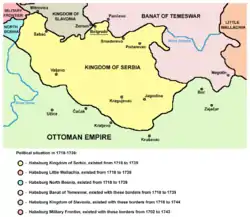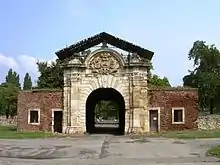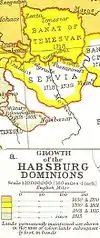Kingdom of Serbia (1718–39)
The Kingdom of Serbia (Serbian: Краљевина Србија / Kraljevina Srbija, German: Königreich Serbien, Latin: Regnum Serviae) was a province (crownland) of the Habsburg Monarchy from 1718 to 1739. It was formed from the territories to the south of the rivers Sava and Danube, corresponding to the Sanjak of Smederevo (or "Belgrade Pashalik"), conquered by the Habsburgs from the Ottoman Empire in 1717. It was abolished and returned to the Ottoman Empire in 1739.
Kingdom of Serbia Königreich Serbien | |||||||||||
|---|---|---|---|---|---|---|---|---|---|---|---|
| 1718–1739 | |||||||||||
 Kingdom of Serbia (1718–39) | |||||||||||
| Status | Crownland of the Habsburg Monarchy | ||||||||||
| Capital | Belgrade | ||||||||||
| Common languages | Serbian, German | ||||||||||
| Religion | Roman Catholic, Serbian Orthodox | ||||||||||
| Government | Crownland | ||||||||||
| Governor | |||||||||||
• 1718–20 | Johann O'Dwyer | ||||||||||
• 1738–39 | George de Wallis | ||||||||||
| Historical era | Early modern period | ||||||||||
| 21 July 1718 | |||||||||||
| 1737–39 | |||||||||||
| 18 September 1739 | |||||||||||
| Currency | Kreuzer | ||||||||||
| ISO 3166 code | RS | ||||||||||
| |||||||||||
During this Habsburg rule, Serbian majority did benefit from self-government, including an autonomous militia, and economic integration with the Habsburg monarchy — reforms that contributed to the growth of the Serb middle class and continued by the Ottomans "in the interest of law and order".[1] Serbia's population increased rapidly from 270 000 to 400 000, but the decline of Habsburg power in the region provoked the second Great Migrations of the Serbs (1737–39).
History
In 1688–89, during the Great Turkish War, the Habsburg troops temporarily took control over most of present-day Serbia, but were subsequently forced into retreat. The Treaty of Karlowitz in 1699 recognized Ottoman authority over most of present-day Serbia, while the region of Bačka and the western part of Syrmia were assigned to the Habsburgs.
Another war broke out in 1716–18, in which Serbs massively joined the Habsburg troops. After the gains of 1718 (following the Treaty of Passarowitz), the Habsburgs sought to integrate Serbia into their empire. The land was officially named the "Kingdom of Serbia", because it was neither a part of the Holy Roman Empire nor the Kingdom of Hungary. The actual administration of the province was in the hands of an appointed governor. Not all the Serb-inhabited territory south of the Sava and Danube rivers that was conquered by the Habsburgs in 1718 was included in the Kingdom of Serbia. A large eastern area was administratively separate as part of the Banat of Temeswar.
After a new Austro-Turkish War (1737–39), the Habsburg monarchy lost all territories south of the Sava and Danube, including the whole territory of the Kingdom of Serbia, and Orșova north of the Danube. It retained, however, the rest of the Banat of Temeswar. The end of Habsburg rule resulted in the second Great Serb Migration (1737–39).
Government

Serbia was jointly supervised by the Aulic War Council and the Court Chamber, and subordinated to a local military-cameral administration.[2]
- Governors
- Johann Joseph Anton O'Dwyer (1718–1720) (known as "General Odijer")
- Charles Alexander, Duke of Württemberg (1720–1733)
- Karl Christoph von Schmettau (1733–1738)
- George Oliver de Wallis (1738–1739)
Serbian Militia
Following the Treaty of Passarowitz (1718), the Habsburgs established the Kingdom of Serbia and appointed the first command cadre of the Serbian National Militia, composed out of two obor-kapetans, ten kapetans, two lieutenants and one major.[3] The obor-kapetans were Vuk Isaković "Crnobarac" and Staniša Marković "Mlatišuma".[3] During the Austro-Russian–Turkish War (1735–39), the Serbian Militia was divided into 18 companies, in four groups (obor-kapetanije).[4]
Demographics
A 1720 regulation declared that Belgrade was to be settled mainly by German Catholics, while the Serbs were to live outside the city walls in the "Rascian" part.[2] It has been estimated that the population in Belgrade in the 1720s did not exceed 20,000.[2] The population increased rapidly from 270,000 to 400,000, but the end of Habsburg power in the region resulted in the second Great Serb Migration (1737–39).
Aftermath

Although the Habsburg administration over this part of present-day Serbia was short-lived, the consciousness about separate political entity was left behind by the Habsburgs, thus local inhabitants never again fully accepted Ottoman administration, which led to Koča's frontier rebellion in 1788 and to the First Serbian Uprising in 1804, which ended direct Ottoman rule over this part of present-day Serbia.
| Wikimedia Commons has media related to Kingdom of Serbia (1718–1739). |
References
- Hupchick 2004, p. 213.
- Hochedlinger 2003, p. 229.
- Istorijski muzej Srbije 1984, p. 11.
- Radovan M. Drašković (1987). Valjevo u prošlosti: prilozi za zavičajnu istoriju. Milić Rakić. p. 22. ISBN 9788671730082.
Хајдучка војска била је подељена на 18 компанија, које су се распореЬивале у 4 групе.
Sources
- Bataković, Dušan T., ed. (2005). Histoire du peuple serbe [History of the Serbian People] (in French). Lausanne: L’Age d’Homme. ISBN 9782825119587.
- Ćorović, Vladimir (2001) [1997]. "Аустриски порази". Историја српског народа (in Serbian). Belgrade: Јанус.
- Đorđević, Miloš (2013). "Kraljevstvo Srbija (1720-1739)". Универзитет у Нишу, Филозофски факултет. Cite journal requires
|journal=(help) - Hochedlinger, Michael (2003). Austria's Wars of Emergence: War, State and Society in the Habsburg Monarchy, 1683-1797. Longman. pp. 229–. ISBN 978-0-582-29084-6.
- Hupchick, Dennis P. (2004). The Balkans: From Constantinople to Communism. Palgrave Macmillan. ISBN 978-1-4039-6417-5.
- Ingrao, Charles; Samardžić, Nikola; Pešalj, Jovan, eds. (2011). The Peace of Passarowitz, 1718. West Lafayette: Purdue University Press. ISBN 9781557535948.
- Istorijski muzej Srbije (1984). Zbornik Istorijskog muzeja Srbije. 21. Istorijski muzej Srbije.
- Langer, Joseph (1889). "Serbien unter der kaiserlichen Regierung : 1717 - 1739". Mittheilungen des k.k. Kriegsarchivs, Wien, Bd. III.
- Pavlović, Dragoljub M. (1901). Austriska vladavina u Severnoj Srbiji od 1718-1739, po građi iz bečkih arhiva. Štamp. Kralj. Srbije.
- Popović, Dušan J. (1950). Србија и Београд од Пожаревачког до Београдског мира, 1718-1739.
- Popović, Dušan J. (2011) [1935]. Beograd u XVIII veku, od 1717. do 1739. Belgrade.
- Stefanović-Vilovsky, Theodor von (1908). Belgrad unter der Regierung Kaiser Karls VI: (1717-1739) mit Benützung Archivalischer und Anderer Quellen. Holzhausen.
- Svirčević, Miroslav M. (2002). "Knežinska i seoska samouprava u Srbiji 1739-1788-delokrug i identitet lokalne samouprave u Srbiji od Beogradskog mira (1739) do Austrijsko-turskog rata (1788)". Balcanica. 32–33 (32–33): 183–196. doi:10.2298/BALC0233183S.
- Zirojević, Olga (2007). Srbija pod turskom vlašću 1459-1804. Belgrade.
.svg.png.webp)
